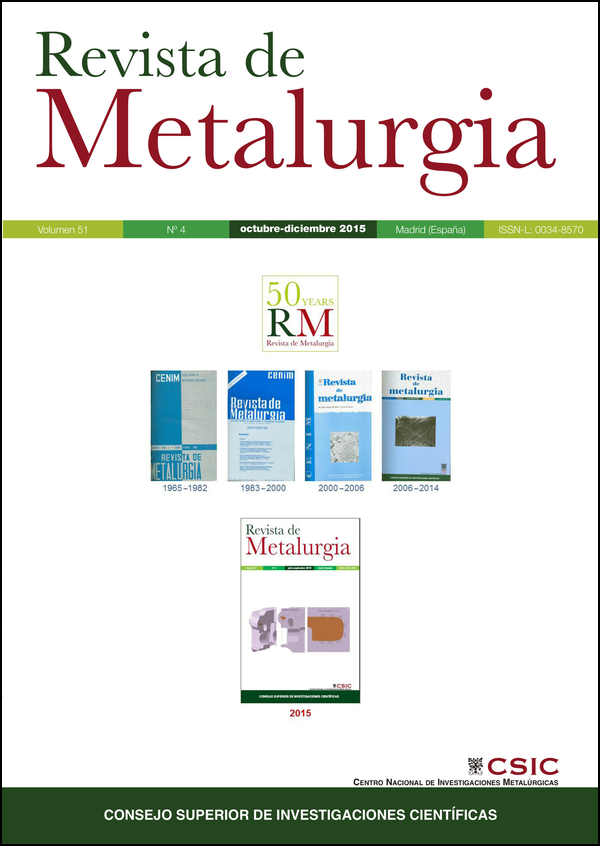An experimental study of high-hydrogen welding processes
DOI:
https://doi.org/10.3989/revmetalm.055Keywords:
Diffusible hydrogen, Glycerin method, Mercury method, Underwater welding, WeldabilityAbstract
This paper presents investigation results of determination of the diffusible hydrogen content in deposited metal obtained by means of two most often used methods-the glycerin method and the mercury method. Relation has been defined between results of those methods in the area characteristic of low-hydrogen as well as high-hydrogen welding processes. Relations available in the literature do not include the diffusible hydrogen content in deposited metal greater than 35 ml/100 g. Extending the scope of analysis of the diffusible hydrogen quantity to an 80 ml/100 g level considerably simplifies carrying out the steel weldability assessment with the use of high-hydrogen processes and with welding in water environment.
Downloads
References
Anon. (1974). Relation between hydrogen contents by IIW and JIS method. International Institute of Welding, Document IIW Doc. II-698-74.
Anon. (1986). Method of measurement for hydrogen evolved from steel welds. International Institute of Welding, Document IIW Doc. II-1073-86.
Coe, F.R. (1972). The comparison of hydrogen levels. International Institute of Welding Document IIW Doc. II-A-305-1972.
Fydrych, D., ¸abanowski, J. (2012). Determining diffusible hydrogen amounts using the mercury method. Weld. Int. 26 (9), 697–702. http://dx.doi.org/10.1080/09507116.2011.592682
Fydrych, D., ¸abanowski, J., Rogalski, G. (2013). Weldability of high strength steels in wet welding conditions. Pol. Marit. Res. 20 (2), 67–73. http://dx.doi.org/10.2478/pomr-2013-0018
Grela, P., Mazur, M. (2002). Comparison investigations of hydrogen diffusing from weld deposit determined by glycerin and mercury methods. Institute of Welding Bulletin 46, 54–55.
ISO 3690 (2012). Welding and allied processes. Determination of hydrogen content in arc weld metal.
Kannengiesser, T., Tiersch, N. (2010). Comparative study between hot extraction methods and mercury method—A national round robin test. Weld. World 54 (5), R108-R114. http://dx.doi.org/10.1007/BF03263496
Karkhin, V.A., Levchenko, A.M. (2008). Computer-aided determination of diffusible hydrogen in deposited weld metal. Weld. World 52 (2), 3–11. http://dx.doi.org/10.1007/BF03266624
Kotecki, D.J. (1992). Hydrogen reconsidered. Weld. J. 71 (8), 35–43.
Kotecki, D.J. (1994). Aging of welds for hydrogen removal. Weld. J. 73 (6), 75–79.
Kozak, T. (2011). Resistance to cold cracking of welded joints made of P460NL1 steel. Adv. Mater. Sci. 11 (3), 20–27. http://dx.doi.org/10.2478/v10077-011-0014-8
Kühn, S., Unterumsberger, F., Suter, T., Poh, M. (2013). New methods for analysis of diffusible hydrogen in high-strength steels. Materials Testing 55 (9), 648–652. http://dx.doi.org/10.3139/120.110483
Kurji, R., Coniglio, N. (2015). Towards the establishment of weldability test standards for hydrogen-assisted cold cracking. Int. J. Adv. Manuf. Tech. 77 (9), 1581–1597. http://dx.doi.org/10.1007/s00170-014-6555-3
López, F.A., Sierra, M.J., Rodríguez, O., Millán, R., Alguacil, F.J. (2014). Non-isothermal kinetics of the thermal desorption of mercury from a contaminated soil. Rev. Metal. 50 (1), e001. http://dx.doi.org/10.3989/revmetalm.001
López, F.A., Alguacil, F.J., Rodríguez, O., Sierra, M.J., Millán, R. (2015). Mercury leaching from hazardous industrial wastes stabilized by sulfur polymer encapsulation. Waste Manage. 35, 301–306. http://dx.doi.org/10.1016/j.wasman.2014.10.009
Padhy, G.K., Ramasubbu, V., Albert, S.K., Murugesan, N., Ramesh, C. (2012). Hot extraction of diffusible hydrogen and its measurement using a hydrogen sensor. Weld. World 56 (7), 18–25. http://dx.doi.org/10.1007/BF03321361
Padhy, G.K., Komizo, Y. (2013). Diffusible hydrogen in steel weldments -a status review. Transactions of JWRI 42, 39–62.
Padhy, G.K., Ramasubbu, V., Parvathavarthini, N., Wu, C.S., Albert, S.K. (2015a). Influence of temperature and alloying on the apparent diffusivity of hydrogen in high strength steel. Int. J. Hydrogen Energ. 40 (20), 6714–6725. http://dx.doi.org/10.1016/j.ijhydene.2015.03.153
Padhy, G.K., Ramasubbu, V., Albert, S.K. (2015b). Rapid determination of diffusible hydrogen in steel welds using a modified gas chromatography facility. J. Test. Eval. 43 (1), 69–79. http://dx.doi.org/10.1520/JTE20130077
Pan’cikiewicz, K., Zielin’ska-Lipiec, A., Tasak, E. (2013). Cracking of high-strength steel welded joints. Adv. Mater. Sci. 13 (3), 76–85.
Pokhodnya, I.K., Yavdishchin, I.R., Paltsevich, A.P., Shvachko, V.I., Kotelchuk, A.S. (2004). Metallurgy of arc welding. Interaction metal with gases. Naukova Dumka, Kiev.
Quintana, M.A. (1984). A critical-evaluation of the glycerin test. Weld. J. 63 (5), 141–149.
Stanisz, A. (2007). The accessible course of statistics with applying STATISTICA PL using the examples from medical science. Linear and non-linear models. Vol. II., StatSoft, Poland.
Ström, C., Elvander, J. (2004). Calibration and verification of the hot extraction method including a comparison with the mercury method. International Institute of Welding Document IIW Doc. II-1543-04.
Swierczyn’ska, A., Fydrych, D., ¸abanowski, J. (2012). The effect of welding conditions on diffusible hydrogen content in deposited metal. Solid State Phenom. 183, 193–200 http://dx.doi.org/10.4028/www.scientific.net/SSP.183.193
Published
How to Cite
Issue
Section
License
Copyright (c) 2015 Consejo Superior de Investigaciones Científicas (CSIC)

This work is licensed under a Creative Commons Attribution 4.0 International License.
© CSIC. Manuscripts published in both the printed and online versions of this Journal are the property of Consejo Superior de Investigaciones Científicas, and quoting this source is a requirement for any partial or full reproduction.All contents of this electronic edition, except where otherwise noted, are distributed under a “Creative Commons Attribution 4.0 International” (CC BY 4.0) License. You may read here the basic information and the legal text of the license. The indication of the CC BY 4.0 License must be expressly stated in this way when necessary.
Self-archiving in repositories, personal webpages or similar, of any version other than the published by the Editor, is not allowed.


















